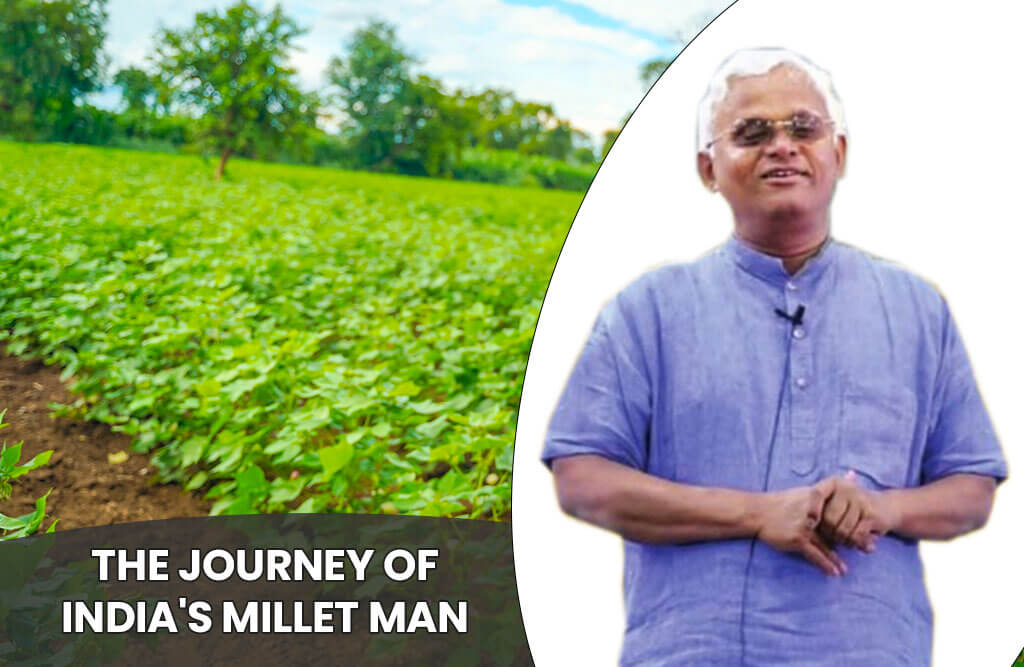
Dr. Khadar Vali, honored with Padma Shri and also known as India's Millet Man, is a pioneering Indian agriculturalist and environmentalist recognized for over three decades for his innovative and sustainable farming practices. He hailed from the Kadapa district of Andhra Pradesh, India, dedicating his life to promoting organic farming and preserving traditional agricultural knowledge.
Dr. Khadar Vali's life is both inspirational and full of struggles. His journey began in his childhood, when he took his initial steps in the field of agriculture with his grandfather. Despite hailing from a small village in the Kadapa district of Andhra Pradesh, he achieved several milestones in farming alongside his family. His parents instilled in him the importance of traditional Indian agriculture and motivated him to study the techniques of excellent farming.
For more than three decades, when Dr. Vali started studying millets, he encouraged a new perspective on agriculture. His journey aimed to convey the message of millets to the people. Dr. Vali explained, “When I was six years old, I went to my grandmother's house in Anantapur district, and there I had millets for the first time. Before that, like everyone else, I was eating rice. The next day, I felt that my bowel movement was very comfortable. After that, I started eating millets and saved as much rice as possible.
When Dr. Vali pursued biochemistry in his adulthood, he discovered that rice is not suitable for the human intestine. He explained, "When I studied biochemistry, I first realized that rice was not made for the human intestine because it quickly fills the blood with glucose, disrupting the blood's condition in a very short time. So, when you know that there should not be more than five grams of glucose in the blood at any given time, I don't know how, despite this, it has been allowed worldwide by doctors and biochemists."
For over three decades since Dr. Vali started researching millets, he has remained an independent scientist. His perspective on agriculture was deeply rooted in traditional and indigenous methods, incorporating natural inputs and techniques to enhance soil fertility and crop productivity. This approach emphasized the use of local resources and sustainable practices, diverging from conventional methods that often rely on synthetic inputs and chemicals.
Dr. Vali believes that before the Green Revolution, the entire world consumed millets. He says, “Throughout the world, the first cultivated grass, that is millets, could grow anywhere. If you delve into literature from around the world, millets are mentioned. It was the food that was already present in human life, could grow in the mountains, on the edges of deserts, and everywhere else. It has been consumed for thousands of years; there are references even in Indian mythology, Prophet Muhammad had porridge made from barnyard millet, and the last supper of Jesus was made from brown top millet, but all this information has been deliberately removed from history.
The Green Revolution changed the way the world eats. It is not only about healthy eating but also about the rights of those farmers whose rights have been taken away in the name of the Green Revolution, sabotaging our food. Even today, the agriculture department claims worldwide that the Green Revolution was necessary because there was a shortage of food, while millets were readily available. These detractors have said many things about millets being suitable only for cattle, birds, and more. Because of this, when I go to villages, many people also believe that millets are only suitable for animals and birds, not for humans."
Traditional Methods: Dr. Vali has remained an independent scientist for over three decades since he started researching millets. His perspective on agriculture was deeply rooted in traditional and indigenous methods, incorporating natural inputs and techniques to enhance soil fertility and crop productivity. He rejected the use of chemical fertilizers and pesticides, which promoted soil health and biodiversity.